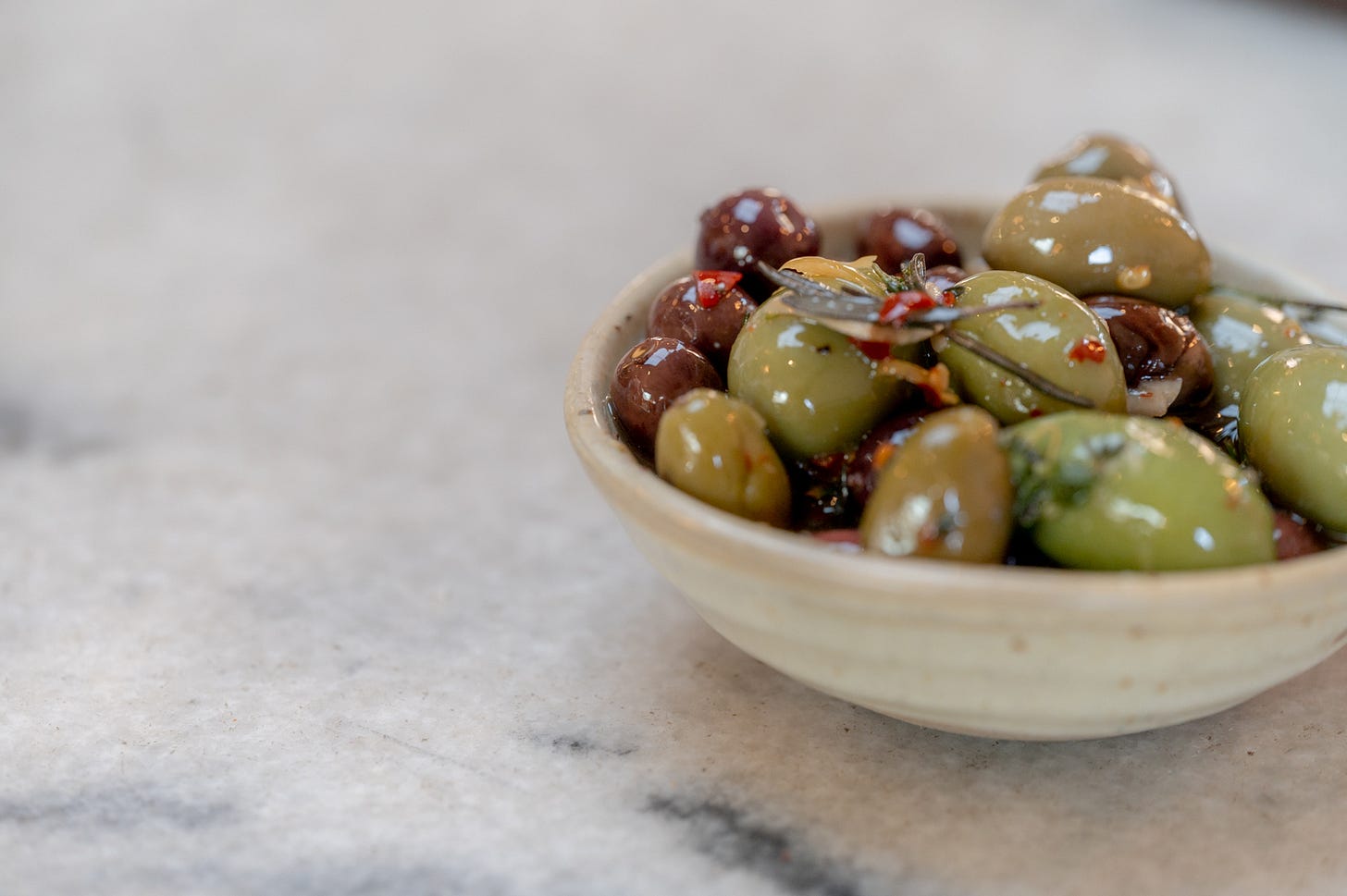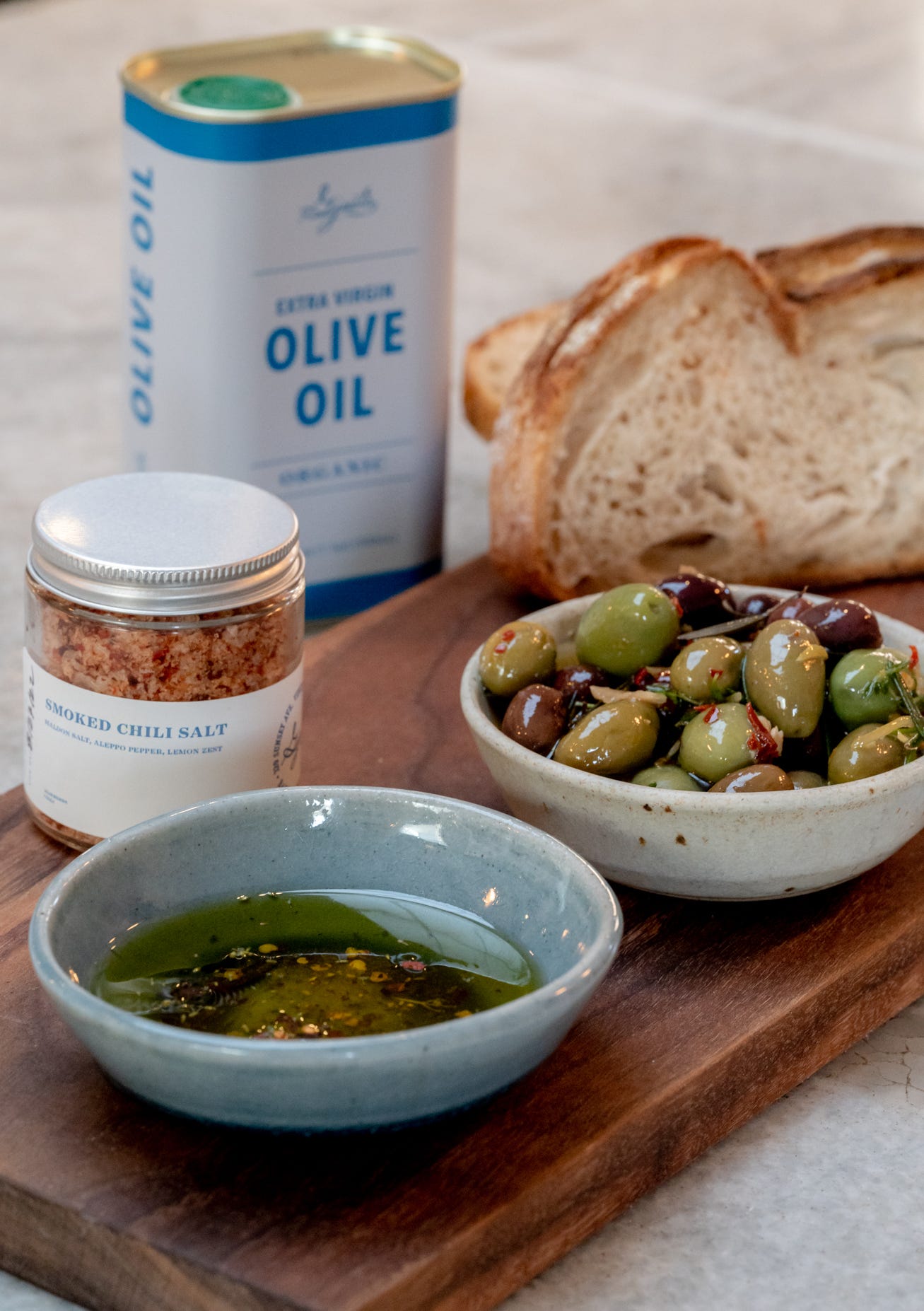The Olive Bowl, Three Ways
How a humble ceramic olive bowl finds uses at countless other tables.
By Nandita Khanna
The olive bowl with its namesake olives. Photo by Trip Davis
Standing at 1-½ inches tall and 5 inches in diameter, it’s hard to imagine that a diminutive ceramic olive bowl can check off so many boxes, but it does. “The bowl was designed because Chef Manny at Gjusta had spent 6 weeks brine-curing olives that came from one of their regular farmers, who’d found himself with surplus,” recalls Shelley Armistead, the CEO of Gjelina Group. Chef Manny was looking for the perfect vessel to serve them in, so Armistead called up Ernie Lee at LA Clay Company, a longtime Gjusta ceramics collaborator, with pretty specific instructions. “I wanted the same shape as the first two bowl pieces, the yogurt & granola and the soup bowl, but smaller,” Armistead says, noting they reviewed three to four rounds of prototypes before landing on one that was just right.
Mezze made perfect with a grouping of olive bowls. Photo by Trip Davis
FOR YOUR TABLE
For Armistead, the olive bowl is clutch when hostessing: She’ll use the bowl as a dipping container, filling it with Gjusta Olive Oil (made from Koroneiki olives) and add a bit of smoked chili sea salt (maldon salt, aleppo pepper, and lemon zest). She serves on a Gjusta cutting board with a loaf of fresh bread from the bakery for guests or just as an afternoon snack for her boys. When it comes to gift gifting, the bowls are her favorite gift to give, particularly when paired with one of the monthly Pantry Boxes.
Shelley's favorite spread: olives, Gjusta's smoked chili sea salt, Gjusta's olive oil and sourdough bread ready for guests on a Gjelina cutting board. Photo by Trip Davis
Armistead suggests stocking up on a few and rotating through them when you’re hosting. “It’s perfectly sized for Gjusta’s cold-case mezzes; when you need to refresh, just bring out a clean bowl,” she says. The best part? The lip of the bowl is just the right width so you don’t end up constantly having to wipe down the edges.
FOR THE RESTAURANTS
While Chef Manny affectionately refers to the bowl as “his” olive bowl, the other chefs at the Gjelina Group have found their own use case. Over at Valle, for example, Chef Pedro uses the vessel to serve their guacamole. Whereas at Gjelina, Chef Juan now uses it as the perfectly sized vessel for their winter citrus panna cotta. (Recipe below.)
Gjelina: Cooking From Venice
FOR SOMETHING SWEET
Winter citrus season is approaching, making this particular dessert one worth introducing into your entertaining repertoire. From the pages of our first Gjelina cookbook, here’s how to recreate our beloved Yogurt Panna Cotta with Winter Citrus at home:
Yogurt Panna Cotta with Winter Citrus
From Gjelina: Cooking From Venice, California (Chronicle Books)
Serves 6-8
2 tsp unflavored gelatin
2 Tbsp cold water, plus 1 cup
½ vanilla bean, halved lengthwise
2 cups heavy cream
Pinch of kosher salt
1-½ cups sugar
1-½ cups Greek-style yogurt
6 mandarin oranges
1 grapefruit
1 oro blanco (you can use pink grapefruit instead)
1 pomelo
2 lemons, cut into ¼-in rounds and seeded
1 cut sliced and seeded kumquats
(¼-in [6mm rounds])
Set a fine-mesh sieve over a 10-by-12-in glass or metal baking dish or pan.
In a small bowl, bloom the gelatin in the 2 Tbsp water, about 3 minutes.
Meanwhile, scrape the seeds from the vanilla bean into a small saucepan. Add the bean pod, cream, salt, and ½ cup of the sugar. Stir over medium-low heat until steaming and bubbles begin to form around the edges. Discard the bean pod.
Put the yogurt in the medium bowl and slowly whisk into the hot cream. Strain a mixture through the sieve into the baking dish. Refrigerate the panna cotta until set, about 2 hours.
Section one of the oranges by cutting off both ends. Set it on one end, and use a paring knife to cut away the peel and pith in strips, starting at the top and following the curves to the bottom. Then, holding the fruit in one hand, carefully insert the blade of the knife between the flesh and the membrane to cut out the oranges, the grapefruit, oro blanco, and pomelo and set aside.
In a medium saucepan over medium heat, bring the lemons, kumquats, remaining 1 cup sugar, and remaining 1 cup water to a simmer. Continue simmering until the sugar has dissolved, about 10 minutes. Remove from the heat and set aside to cool to room temperature, about 20 minutes.
Use a large spoon to scoop out portions of the panna cotta onto dessert plates. Top with the assorted citrus sections and the candied lemons and kumquats. Drizzle on a bit of the juices from the citruses and the syrup from the candied citrus rounds to serve.







